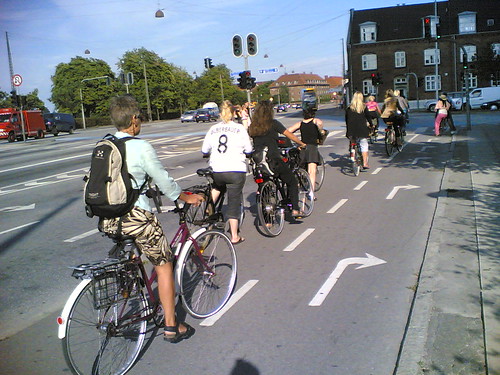
cc licensed ( BY ) flickr photo shared by David Mellis
Details:
1. Copenhagen lanes still need to be fast and convenient to be widely used
- Segregated cycling tracks ("Copenhagen lanes") still need to be faster and more convenient than the alternatives in order to be broadly adopted by urban cyclists. Enhanced safety is necessary but not sufficient to persuade large numbers of people to ride.
- As the major of Copenhagen said:
"Half of Copenhagen residents use bicycles to get to work or school. Not because these individuals are eco-friendly, young or sporty – but because bicycles are convenient and the fastest way to get around in the city" > In Copenhagen, separate but more than equal2. Countries with high cycling rates generally actively inhibit driving
- Countries like the Netherlands and Denmark don't just make cycling attractive, but also inhibit driving through limiting city and residential parking, adding high taxes to purchasing cars and fuel, setting lower speed limits, using congestion taxes and making cars go the long way round or wait longer at intersections.
- Given these anti-car measures typically don't exist in car-centric cultures and it may be unreasonable to significantly penalise drivers outside of the inner city, then there is even more need to make urban cycling a quicker, cheaper and more convenient option as the driving alternative isn't being handicapped.
3. In car-centric places, improve safety without sacrificing speed and convenience
- If you can't (or don't wish to) cripple driving as an alternative, then improvements to any cycling adoption factor (e.g. safety) shouldn't be at the expense of other factors (speed, convenience). Improved transport safety is not a major benefit of cycling; the major benefits, and thus reasons why people cycle, are saving time, saving money, convenience and enjoyment.
- Poor man's Copenhagen lanes that do not let quicker riders easily pass slower riders or let riders enter and exit the lane where they want to or that are less direct, efficient, connected or prioritised than the road, are not going to attract significantly more people to cycling as a transport alternative.
- Yet this is exactly what is often delivered in many cities. For example, in Seattle, one cyclist advises:
"Right now, the advocates of “Copenhagen-style” infrastructure call on cyclists to slow down, and to move off the street into separate lanes that purport to provide “safe” space, but where in reality they have to dodge parked cars and pedestrians. On some of Seattle’s new “protected” bike lanes, they even write “SLOW” on the pavement at regular intervals." > Making cycling convenient and betterThe result is that those who never needed Copenhagen lanes will opt out and just ride on the road and increase conflict with motorists. And those who did want and will use Copenhagen lanes will find that cycling isn't that advantageous after all.
4. Improve safety consistently across the entire cycling route network
- In Melbourne, Copenhagen lanes make up less than 1% of the cycling infrastructure and this kind of ratio is reflective of many car-centric cities. Yet many cycling advocates and planners invest significant time and effort in adding piecemeal Copenhagen lanes that can cover only a small fraction of most people's routes.
- It would be better to invest in improving the entire network of inner city cycling routes holistically so that the safety, quickness, convenience, connectedness and priority is increased in a consistent, sustainable way. There are many lower-cost, specific improvements that can be made. See: > Epic bike lane failures





